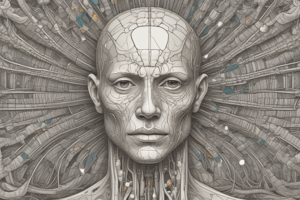Podcast
Questions and Answers
ما وظيفة العصب البصلي (Cranial Nerve I)؟
ما وظيفة العصب البصلي (Cranial Nerve I)؟
- توجيه حركة عضلات العين
- نقل الروائح من الأنف إلى الدماغ (correct)
- توجيه معلومات توازنية ومكانية
- نقل المعلومات البصرية من الشبكية إلى الدماغ
ما هي وظيفة العصب البصلي ضمن أعصاب الجمجمة؟
ما هي وظيفة العصب البصلي ضمن أعصاب الجمجمة؟
- نقل المعلومات السمعية من الأذن الداخلية إلى الدماغ
- التحكم في حركة عضلات العين
- توجيه معلومات توازنية ومكانية (correct)
- التحكم في إدارة حركة اللسان أثناء التحدث والبلع
أي عصب من أعصاب الجمجمة يساهم في توجيه معلومات توازنية وتكانية؟
أي عصب من أعصاب الجمجمة يساهم في توجيه معلومات توازنية وتكانية؟
- العصب البصري (Cranial Nerve II)
- العصب المثني (Cranial Nerve IV)
- العصب الاسترابي-سمعي (Cranial Nerve VIII) (correct)
- العصب البصلي (Cranial Nerve I)
ما هي وظيفة العصب المثني (Cranial Nerve IV)؟
ما هي وظيفة العصب المثني (Cranial Nerve IV)؟
ما وظيفة العصب الملتوي (Cranial Nerve VI) من أعصاب الجمجمة؟
ما وظيفة العصب الملتوي (Cranial Nerve VI) من أعصاب الجمجمة؟
Flashcards are hidden until you start studying
Study Notes
Cranial Nerves: Structures and Functions
Overview
The cranial nerves are a set of 12 paired nerves that arise directly from the brain. They originate from various regions of the nervous system, including the cerebrum and brainstem. Cranial nerves are crucial for providing afferent (sensory) and efferent (motor) innervation to the structures of the head and neck. Understanding their structure and function is essential for comprehending how they contribute to overall human physiology and potential health issues related to these nerves.
Organization of Cranial Nerves
There are several ways to classify and organize cranial nerves. One common approach is to divide them into four main categories based on their function:
-
Purely sensory (afferent): Cranial nerves I (olfactory), II (optic), and VIII (vestibulocochlear) are considered purely sensory nerves because they primarily convey information from the external environment to the brain.
-
Purely motor (efferent): Cranial nerves III (oculomotor), IV (trochlear), VI (abducens), XI (spinal accessory), and XII (hypoglossal) are purely motor nerves because they primarily control muscular contractions and movements.
-
Mixed (sensory and motor): Cranial nerves V (trigeminal), VII (facial), IX (glossopharyngeal), and X (vagus) are mixed nerves because they contain both sensory and motor fibers within the same nerve bundle.
Structure and Function
Each cranial nerve plays a unique role in the body's sensory and motor systems. Let's take a closer look at their specific structures and functions:
Sensory (Afferent) Cranial Nerves
Olfactory Nerve (Cranial Nerve I)
The olfactory nerve provides the sense of smell by transmitting olfactory stimuli from the olfactory epithelium in the nostrils to the olfactory bulb in the brain.
Optic Nerve (Cranial Nerve II)
The optic nerve conveys visual information from the retina to the brain, allowing us to perceive the world around us.
Vestibulocochlear Nerve (Cranial Nerve VIII)
The vestibulocochlear nerve consists of two components: the vestibular nerve, which communicates information about balance and spatial orientation, and the cochlear nerve, which transmits auditory information from the inner ear to the brain.
Motor (Efferent) Cranial Nerves
Oculomotor Nerve (Cranial Nerve III)
The oculomotor nerve controls the movements of the extraocular muscles, enabling us to move our eyes horizontally and vertically.
Trochlear Nerve (Cranial Nerve IV)
The trochlear nerve regulates the superior oblique muscle, assisting in horizontal eye movements.
Abducens Nerve (Cranial Nerve VI)
The abducens nerve controls the lateral rectus muscle, helping us move our eyes towards the opposite direction when looking from one side to another.
Spinal Accessory Nerve (Cranial Nerve XI)
The spinal accessory nerve innervates the sternocleidomastoid and trapezius muscles, facilitating head rotation and stabilization.
Hypoglossal Nerve (Cranial Nerve XII)
The hypoglossal nerve is responsible for controlling the movement of the tongue during speech and swallowing activities.
Mixed (Sensory and Motor) Cranial Nerves
Trigeminal Nerve (Cranial Nerve V)
The trigeminal nerve is a mixed nerve, containing both sensory and motor fibers. It is involved in the sensation of touch, pain, temperature, and proprioception in the head and face, as well as the motor control of the muscles of mastication.
Facial Nerve (Cranial Nerve VII)
The facial nerve facilitates the contraction of the muscles of facial expression and innervates salivary and sweat glands.
Glossopharyngeal Nerve (Cranial Nerve IX)
The glossopharyngeal nerve is a mixed nerve that innervates the stylopharyngeus muscle, contributes to the sensation of taste in the posterior third of the tongue, and carries parasympathetic fibers to the parotid gland.
Vagus Nerve (Cranial Nerve X)
The vagus nerve is a major mixed cranial nerve that provides parasympathetic innervation to numerous organs, including the thorax and abdomen, and conveys general visceral sensation from the heart, lungs, esophagus, and other organs.
Studying That Suits You
Use AI to generate personalized quizzes and flashcards to suit your learning preferences.




